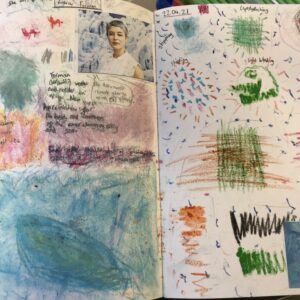Watercolour Paintings by Paul Klee
Take a close look at these paintings. Use the questions to talk about them as a class.
Klee was born in 1879 in Switzerland. When he was 35 he visited Tunisia in Africa, where his experience of the light and colours of the landscapes and architecture helped awaken his interest in colour.
He became less interested in painting exactly what he saw and in fact from 1915 onwards he never again worked from a model. Instead, he became interested in painting the colours around him, letting them detach themselves from the objects the colours were on. In this way his worked moved towards Abstraction.
He became interested in creating fantastical worlds, full of symbols, shapes, colour and line.
He took his inspiration from the world around him, and his imaginative response to the world, and also from poetry, music and literature.
Sometimes his work was serious and meditative, other times it was full of humour. He also loved the sounds of words and phrases and the titles of works were often very important to Klee.
Battle scene from the funny and fantastic opera “The Seafarers” (1923). Painting by Paul Klee. Original from the Kunstmuseum Basel Museum
The Firmament Above the Temple (1922) by Paul Klee. Original from The MET Museum
Questions to Ask Children
Describe what you see.
Can you see the landscape and the sky? How has Klee painted them?
How does the painting make you feel?
Temple Gardens (1920) by Paul Klee. Original from The MET Museum
Questions to Ask Children
Describe what you see.
How does this landscape make you feel?
If you were there, in the painting, how would you feel?
Tell me about the colours. Why do you think Klee choose these colours?
Persian Nightingales (1917) by Paul Klee. Original portrait painting from The Art Institute of Chicago.
Questions to Ask Children
Describe what you see.
What materials do you think Klee used?
Can you see two letters?
The R and the N stand for Rose and Nightingale. Can you spot the rose and the Nightingales in the painting?
How does this painting make you feel?
How do you think the painter felt when he painted it?
This is an animation of one of Klee’s paintings.
Questions to Ask Children
How do you feel watching the animation?
What kind of world has Klee/the animator created?
If you could animate one of the paintings above, how would you bring it to life? What would you make it do?
In this video Klee’s paintings are shown alongside music.
Questions to Ask Children
How does the music change the way you look at the paintings?
Do you think Klee would have liked this video (remember Klee made his paintings at a time when there were very few films).






